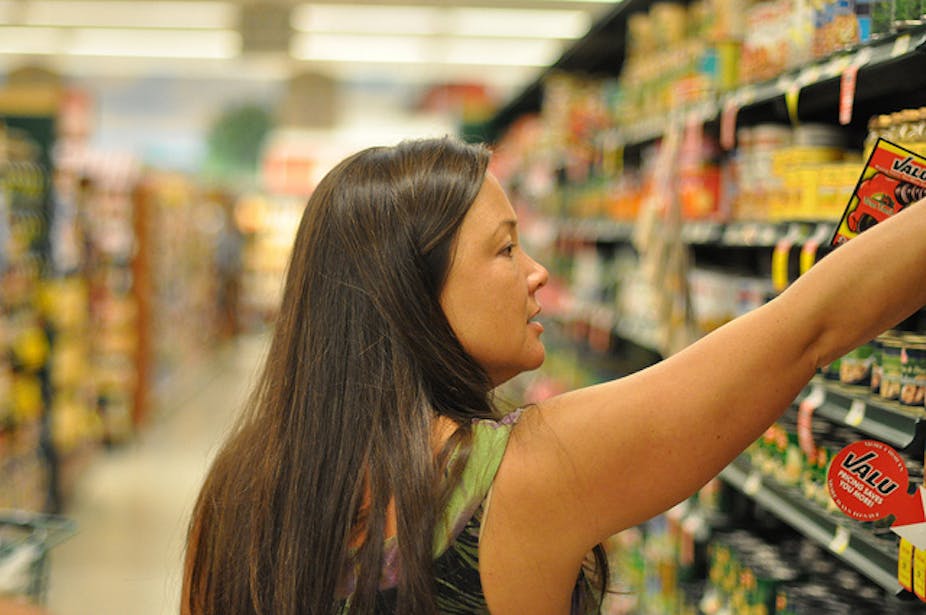The federal government is likely to introduce a star system for food packages next year to help consumers make healthier food choices, ABC’s Lateline reported last week. Much like the energy star rating system on white goods, the proposed star system for food labels would see healthier choices carrying more stars than less healthy choices.
The introduction of an easy-to-understand food labelling system was a key recommendation of the 2011 Blewett review of food labelling. Over the past year, public health experts, consumer groups, representatives from the food and retail industries, and state and territory governments (plus New Zealand) have participated in a Commonwealth-led process aimed at developing a front-of-pack food labelling system that could be applied nationwide.
But before the consultation started, Federal Parliamentary Secretary Catherine King ruled out the possibility of traffic light food labels, despite strong support from public health groups. Instead, King flagged an interest in a star rating scheme proposed by the Institute of Medicine (IOM) in the in the United States, an option that has proved much more palatable for the food industry.
Manufacturers have used the food industry’s own daily intake guide (DIG) since 2006 but it doesn’t meet the Blewett review’s requirement for an “interpretive” system. It only presents information about the contribution that a serve of a food or drink contributes to the supposedly “average” person’s daily dietary requirement. DIG labelling has been criticised as being meaningless for most of the population.
Star labelling
The IOM’s proposed star scheme would display the amount of energy (calories in the US) and award a star if a product passed nutrient criteria for saturated and trans fats, sodium (salt) and added sugars – one star for passing each nutrient criteria.
But the labelling system is not currently in the marketplace, and no government, retailer or food manufacturer has committed to adopt it.

The star scheme proposed in Australia is very different in that it uses the stars to indicate overall healthiness: the more stars, the healthier the food.
The Australian star scheme is intended to be based on a nutrient profiling criteria developed by the food regulator, Food Standards Australia New Zealand. This takes into account a product’s kilojoule, saturated fat, sugar and sodium content, as well as how much fibre, protein, fruit, vegetables, nuts and legumes are in a product.
Neither star scheme has been subject to testing to see how well consumers understand the schemes and how effective they might be in guiding healthier choices.
The least worst option
Several new star labelling concepts will be tested with Australian consumers in early 2013. The schemes have been developed by a committee of government, industry and health stakeholders who have publicly declared polarised positions, with health groups supporting a traffic light system and industry groups standing behind the daily intake guide.
The concern is that the scheme being developed is likely to be the least offensive option for food industry groups and something that public health groups could potentially live with, but it won’t be the most effective in promoting healthy choices.
With high levels of diet-related chronic disease in the community, Australians need the right information to make healthy lifestyle changes. When it comes to packaged food and beverages, clear, easy-to-interpret food labels assist shoppers to make healthier choices. And evidence suggests front-of-pack labelling would be a cost effective strategy.

The case for traffic light food labels has recently strengthened in the United Kingdom, where traffic light labels have been on products in various forms since 2007. In October, the UK government announced a consistent front-of-pack food labelling system would be introduced in 2013. The system is reported to be a combination of guideline daily amounts (similar to DIG), traffic light colour coding and “high, medium or low” guidance to indicate levels of fat, salt and sugar and how much energy is in each product.
Around the same time, several UK supermarkets that had previously been resistant, announced that they would introduce traffic light labels. This means most UK supermarkets will use traffic lights, despite food manufacturers remaining silent.
Ultimately, we need consumer testing to determine which front-of-pack food labelling scheme would be effective in promoting healthy choices. We know that competing schemes just fuel consumer confusion so one single consistent scheme is important.
Voluntary, not mandatory
Perhaps the biggest challenge to the introduction of the new food labelling scheme is that while the agreed scheme will be endorsed and promoted by government, it will not be a mandatory standard that becomes part of the Food Standards Code. Instead, it will be a voluntary scheme that will rely on the goodwill of food manufacturers and food industry organisations such as the Australian Food and Grocery Council to champion its adoption.
Yet in this highly-politicised process, the food lobby won’t give up on its DIG scheme without a fight. Gary Dawson the new CEO of the Australian Food and Grocery Council was quoted last week as saying, “having invested in DIG it doesn’t make sense to take information away”.
On the other side of the debate, public health groups will continue to argue that a traffic light labelling system is most effective in guiding healthier choices, but we recognise that it will not be implemented as part of this process.
Knowing that any scheme introduced in Australia will be voluntary, and given the food industry’s increasing reluctance to walk away from its DIG labels, it is questionable what the uptake of a new scheme will be.
But with so much effort put into the consultation process over the past 12 months, it’s important that we don’t lose sight of the goal of an improved labelling scheme – to empower consumers to make informed choices and facilitate better health outcomes.
This article was co-authored by Wendy Watson, Nutrition Project Officer at Cancer Council NSW.

